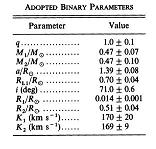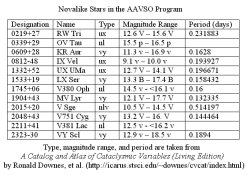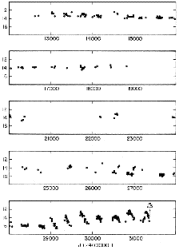The Eclipsing Nova-Like Variable UX Ursae Majoris
 |
| Parameters regarding UX UMa as found in Baptista, et al. (1995). Click image to enlarge. |
UX Ursae Majoris was first discovered to be variable in 1933 by S. Beljawsky during his investigation of Simeiz Observatory plates. With a relatively constant light curve interrupted by eclipse-induced drops in magnitude, UX UMa was orginally thought to be an Algol-type eclipsing variable. UX UMa's earliest claim to fame was its ultra-short orbital period of 0.1967 days, or 4.7 hours! Such short-period eclipsing systems would ordinarily be classified as W Ursae Majoris type, however, the constant light between eclipses kept it as a member of the Algol class. Between the 1950s and early 1970s, spectroscopic and photometric studies revealed that UX UMa was not an Algol-type variable, but rather an eclipsing nova-like system (see Smak 1994 and references therein).
Although UX UMa's quick-period record has since been broken (WZ Sge, for example, has an orbital period of 81.6 minutes) and its type reclassified, it remains a revered variable amongst astronomers. AAVSO observers have been monitoring UX UMa since 1984 and have contributed over 3700 observations, as archived in the AAVSO Inernational Database. The star can be seen to vary between 12 to 14.5 and displays an assymetrical eclipse with a depth of about 1 magnitude. With the title of "nova" in its name, one would expect more activity than described. But is UX UMa in fact a nova waiting to happen?
Nova-Who?
 |
| "The cataclysmic variables, comprising the classical novae, dwarf novae and nova-like variables provide the amateur variable star observer with the greatest opportunities for important and indispensable contributions to the current progress of astronomy." - Warner 1986
Image credit: Mark A. Garlick |
The nova-like (NL) stars belong to the cataclymic variable (CV) family of variable stars. The general model for members of this class is that of a compact binary pair with a a solar-type secondary star, a white dwarf primary, and an accretion disk around the primary component. Due to evolutionary effects, the secondary star is losing matter via the accretion disk to the white dwarf. Cataclysmic variable stars are divided into the nova, recurrent nova (see RS Oph), nova-like, dwarf nova (for examples, see: U Gem, SU UMa, and Z Cam), and magnetic variable (see AM Her) types, with further subclassification within each level. Although the close binary system is indicative of such stars, frequency, amplitude, and nature of the outbursts (or lack thereof) set them apart.
The NL class is a very heterogeneous group of stars and accordingly, has been plauged with a somewhat nebulous definition. It is not surprising then that many of the objects now classified as "nova-like" were once thought to be irregular, Mira, flare star, or a variety of other types of variables. More observations, not only ground-based, but also those of UV and X-ray have helped to mold present understanding and classification. While NLs share a variety of photometric and spectroscopic features in common with the dwarf novae, such as flickering, humps, and eclipses, they seem to lack the all-anticipated outburst behavior. That is, NLs exhibit relatively constant lightcurves. How then can the NL variables boast to be a member of the prestigious CV family? According to Warner (1995), the NL clan is defined as follows:
 |
| A table of nova-like stars in the AAVSO observing program. Click image to enlarge. |
Nova-like variables include all the 'non-eruptive' CVs. This apparent oxymoron is removed by the belief that the NLs include pre-novae, post-novae and perhaps Z Cam stars effectively in permanent standstill, for all of which our observational baseline (typically ~1 century) is too short to reveal their cataclysms. In addition, the VY Scl stars [see the summary in TT Ari] are included, which show additional reductions in brightness from an approximately constant maximal magnitude, caused by temporary lowering of the rate of mass transfer from the secondary.Most NLs have emission line spectra, but a subgroup show in addition broad absorption lines. The latter will here be termed UX UMa stars; this terminology has occasionally been used for all NLs.
Warner (1995) continues by noting that the magnetic CVs, known as polars and intermediate polars, are sometimes included in with the nova-like variables, but are usually treated separately because of their magnetic properties.
Beware the Quiet Types!
One should not dismiss the nova-like class of variables stars because of their apparent lack of activity. If anything, these stars should be watched all the more for possible nova events! According to Warner (1986), almost every nova has been found to have been a nova-like variable on archival photographic plates. However, no previously known variable has become a nova. Based on archival photographic plate research, Robinson (1975) reported that some prenovae have been seen to brighten by up to two magnitudes in the year or so prior to a nova eruption.
With this knowledge, Warner (1986) advises that, "any nova-like variables showing such a steady rise would be worthy of almost hourly attention by visual observers" and adds that, "a daily watch on these nova-like variables should result in the earliest possible notice of the rise of a classical nova" (Warner 1995). Therefore, If you suspect that UX UMa is undergoing some unusual behavior, especially if it seems to brigthening beyond its 12th magnitude norm, contact the AAVSO immediately. The AAVSO will then alert the astronomical community of this extraordinary event!
Things That Go Bump, Flicker, and Fade in the Night
While waiting for the possible UX UMa nova episode to occur, observers can look for other features seen in the UX UMa light curve, such as flickering, oscillations, humps, and eclipses.
Flickering is a phenomenon seen in all photometric states of CVs, except during outbursts of classical and recurrent novae, during the extreme low state of some stars, as well as during eclipse. The UX UMa stars are seen to flicker in magnitude on the timescale of minutes, with amplitudes from several hundreths to several tenths of a magnitude, with the amplitude being larger at shorter wavelengths. Although the exact source of the flickering is not known, it is thought that it may originate from the innermost accretion disk with the boundary layer and white dwarf surface, and the region of impact of the stream of matter from the secondary to the accretion disk (Bruch 2000).
On a more periodic level, rapid coherent oscillations of 0.002 mag amplitude and with a 29-second period have been detected in UX UMa (Warner and Nather 1972). The oscillations are seen to undergo a -360° phase shift during eclipse (i.e., one cycle is lost). Again, although the origin is uncertain, Knigge, et al. (1998) explain that the source may be the result of direct light from a hot compact region near the disk center and from reprocessed light emitted by the source in the accretion disk atmosphere and probably the bright spot.
 |
 |
| UX UMa eclipse samples from the AAVSO International Database. Click images to enlarge. |
Eclipses appear to take similar shape in the CV family as well. However, unlike dwarf novae, an eclipse-related hump seen in the light curve can occur before as well as after the eclipse. Further similarities in the light curves of nova-like and dwarf novae stars are that they exhibit eclipses that are "noticably asymmetric, in changing the slope of ingress shortly after the first contact and most notably, in normally having a pronounced, though highly variable hold at egress; the bottom usually rounded" (Hack and la Dous 1993). While the dominant contribution to the flux comes from the accretion disk, which is believed to be occulted during eclipse, it is said that the relatively fainter hot spot may be responsible for the orbital hump and for the standstill near the end of the UX UMa eclipse (Smak 1994).
While CVs are important in helping astronomers learn more about accretion disk processes, eclipsing CV systems can provide significant information since they help astronomers to learn about the spatial distribution of the disk and other components. Hence, eclipsing CVs are extremely important in helping astronomers determine properties and test theories regarding these and other accretion disk systems.
We're Watching You, UX Ursae Majoris
UX UMa observers, both new and seasoned, are asked to obtain up-to-date AAVSO charts. As Warner advises, estimates of this variable should be made every clear night and much more frequently if seen to exhibit some unusual behavior. Additionally, observers may want to follow UX UMa's eclipses. Observations during this time should made frequently in order to cover the entire eclipse. Baptista, et al. (1995) provide the following ephemeris for UX UMa's eclipses: Tmin = HJD 2443904.87872(±3) + 0.196671278(± 2)E, where E is the eclipse cycle number. The Julian Date should be recorded to 4 decimal places and the magnitude to 1 decimal place for visual observers and to at least 2 decimal places for PEP and CCD observers. Observations may be submitted to the AAVSO where they will be added to the AAVSO data archives.
For More Information
- Baptista, R., K. Horne, R.W. Hilditch, K.O. Mason, and J.E. Drew. "Hubble Space Telescope and R-Band Eclipse Maps of the UX Ursae Majoris Accretion Disk." The Astrophysical Journal, 448, 1995, 395-415.
- Bruch, A. "Studies of the Flickering in Cataclysmic Variables. VI. The Location of the Flickering Light Source in HT Cassiopeiae, V2051 Ophiuchi, IP Pegasi and UX Ursae Majoris." Astronomy and Astrophysics, 359, 2000, 998-1010.
- Hack, M. and C. la Dous, eds. Cataclysmic Variables and Related Objects. Washington, DC: NASA Scientific and Technical Information Branch, 1993.
- Knigge, C., N. Drake, K.S. Long, R.A. Wade, K. Horne, and R. Baptista. "Recovery of 29 Second Oscillation in Hubble Space Telescope Eclipse Observations of the Cataclysmic Variable UX Ursae Majoris." The Astrophysical Journal, 499, 1998, 429-443.
- Mayall, M. "Recent Variations of RR Telescopii." Harvard College Observatory Bulletin, 919, 1949, 15-17.
- Robinson, E.L. "Preeruption Light Curves of Novae." The Astronomical Journal, 80, 1975, 515-524.
- Smak, J. "Eclipses in Cataclysmic Variables with Stationary Accretion Disks. II. UX UMa." Acta Astronomica, 44, 1994, 59-74.
- Warner, B. and R.E. Nather. "Observations of Rapid Blue Variables - XII UX Ursae Majoris." Monthly Notices of the Royal Astronomical Society, 159, 1972, 429-444.
- Warner, B. "Cataclysmic Variables." Journal of the AAVSO, 15.2, 1986, 163-168.
- Warner, B. Cataclysmic Variable Stars. New York: Cambridge UP, 1995.
This month's Variable Star of the Season was prepared by Kerri Malatesta, AAVSO Technical Assistant.


